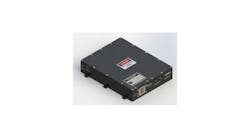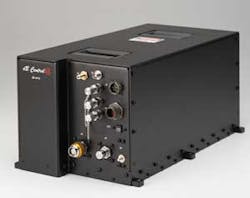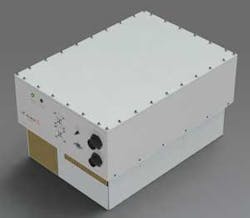This file type includes high resolution graphics and schematics when applicable.
Traveling-wave tubes (TWTs) are one of the older technologies in the RF/microwave industry, but certainly not an obsolete one. As some rack-mount amplifiers and amplifier modules recently released from dB Control show, TWTs and TWT amplifiers (TWTAs) still provide one of the most effective means of achieving high output-power levels at microwave frequencies—whether for continuous-wave (CW) or pulsed signal applications—and these are amplifier products that can handle the demanding conditions of shock and vibration from airborne applications. This latest line of amplifier products serves frequencies from 6 to 35.5 GHz and pulsed power levels as high as 1 kW from 9 to 10 GHz.
Some of these new amplifier modules are quite compact, in spite of the high output-power levels. For example, model dB-4127 (Fig. 1) is a microwave power module (MPM) that can be used for CW or pulsed signals from 6 to 18 GHz. It delivers 150 W CW output power from 6.0 to 6.5 GHz and 200 W CW output power from 6.5 to 18.0 GHz. This module can work with pulse widths as narrow as 1 μs at pulse repetition frequencies (PRFs) as high as 10 kHz. The MPM achieves 53-dB gain at its rated output power with -50 dBc spurious levels.
The input VSWR is 2.0:1 or less, while the load VSWR is a maximum of 1.50:1. The MPM is outfitted with SMA female input RF connectors and WRD-650 waveguide RF output connectors, measuring 11.00 × 9.38 × 2.15 in. and weighing 8.5 lbs. It includes protection for the tubes by means of helix-overcurrent, cathode-overvoltage, and over-temperature functions. Model dB-4127 uses conduction cooling to dissipate heat from the TWTs. The unit is designed with a discrete logic interface control with differential or TTL modulation control.
A liquid-cooled amplifier module, the dB-4410 TWTA (Fig. 2), measures just 19.33 × 10.71 × 8.89 in. and weighs 70 lbs, but provides 300 W CW output power from 7.5 to 18.0 GHz with 57-dB minimum gain. Spurious levels are kept in check to -45 dBc. This TWTA is qualified for military airborne environments and is compliant with MIL-STD-461E and MIL-STD-704 requirements. The amplifier has an operating temperature range of -30 to +60°C and is a good match for manned and unmanned airborne data links, electronic-countermeasures (ECM) systems, and electronic-warfare (EW) systems.
For those in need of transmit power at somewhat higher frequencies, two of the company’s latest amplifier models provide generous output power from 34.5 to 35.5 GHz, models dB-3840 and dB-3860. They are designed to handle pulsed signals from 34.5 to 35.5 GHz at duty cycles to 10% and deliver output power levels to 700 W with maximum PRFs to 25 kHz. Model dB-3840 (Fig. 3) offers 60-dB minimum gain with worst-case harmonics of -30 dBc and spurious levels of -50 dBc. It operates at input VSWRs to 2.0:1 and at load VSWRs to 1.30:1.
Input and output signals are connected by means of WR-28 RF input and output waveguide, with a Type-K female port also provided for sample and test purposes. It is housed in a compact enclosure weighing no more than 100 lbs and measuring 18 × 13 × 10 in., including helix over-current, cathode over voltage, over temperature protection.
For those in need of a more traditional, rack-mount TWTA, the dB-3860 (Fig. 4) provides this high-power performance from 34.5 to 35.5 GHz in a larger enclosure. Nevertheless, it maintains the design based on a wideband periodic-permanent-magnet (PPM) focused, conduction-cooled TWT. It operates at maximum duty cycles to 10% and is designed for PRFs to 25 kHz with 0.2 to 20.0 μs pulse widths.
Both amplifiers incorporate RS-485 as standard remote-control protocol, with other protocols—such as RS-232, RS-422, and Ethernet—available as options. The two high-frequency amplifiers are designed for use at altitudes to 15,000 ft. and across operating temperatures from at least -40 to +55°C (the MPM is usable to -30°C).
The rack-mount model dB-3860 measures 24.5 × 19.0 × 7.0 in. and weighs as much as 100 lbs. It includes forced-air cooling and WR-28 input and output ports, with a Type-K female connector sample port. As with the module, it provides at least 60-dB gain with -30 dBc harmonics and 50 dBc spurious levels. It can be used at altitudes to 10,000 ft at temperatures from -20 to +55°C. It is a suitable companion for a host of applications, including for test and measurement, radar-cross-section (RCS) applications, EW simulation, and antenna pattern measurements.
For applications requiring extremely high signal power, model dB-3758 is a MPM capable of 1000 W pulsed output power from 9 to 10 GHz at duty cycles to 6%, for use in a variety of different radar systems. This compact unit integrates a PIN diode modulator, solid-state driver amplifier, and a miniature TWT to achieve the final output power. It includes a low-noise, high-voltage power supply section to optimize efficiency. This MPM, with integrated forced-air cooling, is well suited for both manned and unmanned applications. It handles signal pulse widths to 50 μs maximum at PRFs to 40 kHz with nominal gain of 60 dB.
Harmonic levels are typically -15 dBc while spurious levels are typically -70 dBc. The compact module measures 12 × 9.65 × 4.90 in. and weighs 17.6 lbs or less. It can be used at altitudes to 30,000 ft. across operating temperatures from -40 to +63°C. The module is built with a female SMA input port, WR90 waveguide output port, and female SMA sample port; it is powered by +28-VDC prime power.
Of course, applications can be quite different, and each may have its own requirements in terms of signal fidelity and control. But these TWT-based amplifiers and modules provide efficient effective transmit power for both pulsed and CW systems through millimeter-wave frequencies, and they provide dependable building blocks for manned and unmanned applications where high transmit power levels are needed.
dB Control, 1120 Auburn St., Fremont, CA 94538; (510) 656-2325, FAX: (510) 656-3214.
This file type includes high resolution graphics and schematics when applicable.





